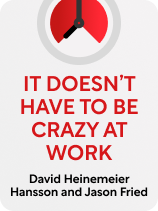

This article is an excerpt from the Shortform book guide to "It Doesn't Have to Be Crazy at Work" by David Heinemeier Hansson and Jason Fried. Shortform has the world's best summaries and analyses of books you should be reading.
Like this article? Sign up for a free trial here.
Why should managers give employees autonomy? Do employees need private time at work?
A more relaxed workplace can be more productive than a frenzied one. As long as you give employees private time to work without being distracted, you don’t need to check in on them every minute of every workday.
Let’s discuss how to give employees autonomy, according to It Doesn’t Have to Be Crazy at Work by Jason Fried and David Heinemeier Hansson.
Give Your Employees Private Time
The more time someone has to work on a single task without being interrupted, the more they can get done within that time. Even a single brief interruption can fragment someone’s attention and drastically reduce their productivity. For this reason, Fried and Hansson structure their organization to give their employees as much uninterrupted private work time as possible.
(Shortform note: In Deep Work, Cal Newport agrees that people are most productive during uninterrupted private time—what he calls “deep work.” Even if you don’t have an organization to manage, awareness of the value of deep work can help you maximize your productivity. To carve out deep work time, Newport recommends adopting one of four work schedules: a secluded schedule in which you go “off the grid” to spend all your time in deep work, a periodic schedule in which regularly you set aside days or weeks to focus on deep work, a daily schedule in which you reserve a few hours every day for deep work, or an ad hoc schedule in which you use any free time that appears in your schedule for deep work.)
To build an organization that gives employees autonomy, Fried and Hansson offer three tips.
Tip #1: Maintain a Distraction-Free Workspace
Although employees need time by themselves without any distractions to get work done, Fried and Hansson explain that most modern offices give them the opposite: open floor plans in which people take phone calls or make loud conversations where everyone can hear them. Consequently, many employees feel pressured to work during evenings at home or to come into the office hours early just to have time to get tasks done without distractions. They end up working far more than 40 hours a week and still get less done than they should.
To remedy this, Fried and Hansson recommend running your office like a library—everyone in the public space must be quiet and avoid distracting others. People already know how to behave at the library, so this kind of cultural shift is relatively easy to implement.
| Balancing Distraction-Free Time With Collaboration Although open floor plans are full of distractions, some research backs up the idea that they help foster creativity and collaboration. As Annie Murphy Paul explains in The Extended Mind, the farther away two people work from one another, the less frequently they’ll communicate with one another about their work—a statistical relationship known as the “Allen curve.” In turn, frequent interaction between co-workers leads to more insights and innovative breakthroughs—especially if they have different fields of expertise, yielding unique interdisciplinary insights. Open floor plans in which workers spend all their time right next to each other should (in theory) yield more of these insights. Furthermore, running your office like a quiet library (as Fried and Hansson suggest) might not be enough to reduce all distractions. Paul argues that a worker seeing people move around them is enough to distract them from their work, even if no one is talking aloud or trying to get their attention. To ensure that your employees can be productive at work without feeling pressured to put in extra hours, Paul recommends an office plan that gives workers the privacy they need to be productive while fostering collaboration. Give each employee a private workspace, but build the office in such a way that people naturally interact while they’re not working. For instance, have workers enter the building through communal spaces and eat together in shared cafeterias. This can naturally trigger conversations that result in valuable collaboration. |
Tip #2: Let Workers Keep Their Schedules Private
Fried and Hansson also suggest protecting your team members’ time by allowing them to keep their schedules private. When a worker’s day-to-day schedule is publicly available, it encourages coworkers to claim that person’s time. For instance, if Miranda sees that Amir’s schedule is empty for the next two hours, she might pop into his office to quickly get his opinion on her ideas for improving the company’s training program. This interruption wrecks Amir’s productivity for the whole afternoon, and Miranda’s training program is only slightly improved by his input.
(Shortform note: By contrast, some experts prefer to post their schedule where everyone at work can see it, noting that it helps them keep themselves accountable and productive. You’re more likely to plan out responsible ways to use your time if you know that peers will be able to judge your schedule. You may be able to benefit from a public schedule as long as you plan blocks of time to work in private and make it clear to your coworkers that you don’t want to be interrupted during this time.)
Instead of leaving your employees vulnerable to interruptions whenever they have free time, Fried and Hansson recommend instructing your most knowledgeable employees to host university-style “office hours”: They should schedule a regular time in which coworkers can consult them and save the rest of their time at work solely for themselves. If a coworker needs an expert’s input, they have to wait for their office hours to roll around.
(Shortform note: Setting office hours is a form of “task batching”: the productivity practice of completing similar small tasks during a predetermined time rather than sporadically throughout the day. This saves you time because it removes the need to frequently switch between different types of tasks and adjust to each new context. You can use task batching to efficiently complete many different kinds of tasks—for instance, set a predetermined time every day or two to check your email rather than answering emails one at a time as they enter your inbox.)
Tip #3: Embrace Asynchronous Communication
According to Fried and Hansson, many organizations hurt their employees’ productivity by creating a culture in which they’re expected to constantly check their messages, stay aware of the discussion going on in real-time chatrooms, and respond as quickly as possible to anyone who mentions them. The threat of missing important information frightens employees into perpetually keeping tabs on all this synchronous communication—at the expense of their personal responsibilities.
To avoid this, the authors recommend relying primarily on asynchronous rather than real-time communication in the workplace. If someone needs to share important information, they shouldn’t just post it in a chatroom and assume that everyone will see it. Instead, they should create a permanent document that relevant team members can consult whenever they want. This way, workers are free to ignore real-time chats and concentrate on their work, trusting that they can seek out necessary information later. That said, if you need to communicate something urgent, real-time chat may be the right tool for the situation.
Another benefit of asynchronous communication is that it facilitates deeper thinking, Fried and Hansson note. When employees share important information and seek collaborative input, they’ll receive more intelligent feedback if other team members have time to think deeply. In contrast, people at most companies present their ideas in real time (for instance, in an in-person meeting) and expect immediate feedback. Consequently, their colleagues’ underdeveloped first impressions compromise their ideas and decisions.

———End of Preview———
Like what you just read? Read the rest of the world's best book summary and analysis of David Heinemeier Hansson and Jason Fried's "It Doesn't Have to Be Crazy at Work" at Shortform.
Here's what you'll find in our full It Doesn't Have to Be Crazy at Work summary:
- How today's "hustle culture" ruins the lives of many
- How you can establish more reasonable and sustainable goals
- The three qualifications to look for when scouting for any potential hire






